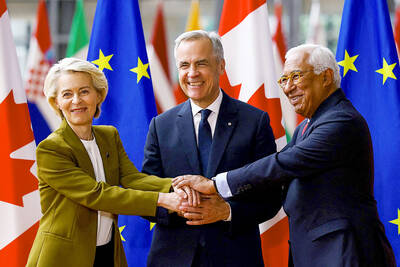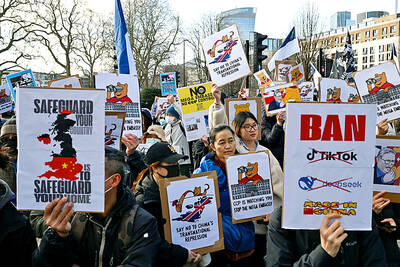Just five years ago, anyone who talked of easing Earth’s climate crisis by fertilizing the seas with iron, scattering particles in the stratosphere to reflect sunlight or building a sunshade in space courted ridicule.
Today, such advocates — “geo-engineers” — are getting a respectable hearing.
Their ideas are still beyond the scientific pale, for they remain contested as risky for the environment and laden with unknowns about cost, practicality and legality.
However, mainstream scientists who once dismissed these projects are now looking at them closely.
And some grudgingly accept that at least some concepts are worth exploring as a possible “Plan B” — a last-resort option if political efforts to tackle global warming fail and catastrophe looms.
Plan A hangs in the balance at the UN talks in Copenhagen, where 194 nations have been gathered together from Monday until next Friday to craft a post-2012 treaty to slash greenhouse-gas emissions.
The negotiations are hideously complex, however, a Gordian knot of interlinked issues, national interests and economic stakes.
The plodding, consensus-driven process is being far outstripped by the surge of fossil-fuel emissions, placing Earth on course for as much as 3.5˚C of warming over pre-industrial times, way over a 2˚C threshold widely considered safe.
“A lot of people don’t like to say that Plan A is not working,” Jip Lenstra, a senior scientist at the Energy Research Center of the Netherlands, said at the Copenhagen talks.
“They know that, but they don’t want to say that aloud because it’s very frustrating and it’s not the right signal at the right time,” he said. “If you are working quite hard to make a success of Plan A, and somebody says that we should look at Plan B if Plan A is not successful, that’s not a good strategy.”
Geo-engineering broke new ground this year with an assessment of its options by the UK’s Royal Society, one of the temples of science.
A 12-member panel found that some geo-engineering techniques could have “serious unintended and detrimental effects on many people and ecosystems.”
However, they cautiously said some schemes were technically feasible and could be a useful fallback tool to help the switch to a low-carbon economy provided safety worries and doubts about affordability were answered.
The UN’s Intergovernmental Panel on Climate Change inveighed against geo-engineering schemes in its landmark Fourth Assessment Report in 2007, swiping them in a brief aside as charged with potential risk and unquantified cost.
It now intends to do its own evaluation of the mavericks.
The Royal Society said geo-engineering fell into two main categories.
The most promising entails removal of carbon dioxide, such as by planting forests and building towers that would capture carbon dioxide from the air.

The team behind the long-awaited Vera Rubin Observatory in Chile yesterday published their first images, revealing breathtaking views of star-forming regions as well as distant galaxies. More than two decades in the making, the giant US-funded telescope sits perched at the summit of Cerro Pachon in central Chile, where dark skies and dry air provide ideal conditions for observing the cosmos. One of the debut images is a composite of 678 exposures taken over just seven hours, capturing the Trifid Nebula and the Lagoon Nebula — both several thousand light-years from Earth — glowing in vivid pinks against orange-red backdrops. The new image

Canada and the EU on Monday signed a defense and security pact as the transatlantic partners seek to better confront Russia, with worries over Washington’s reliability under US President Donald Trump. The deal was announced after a summit in Brussels between Canadian Prime Minister Mark Carney and European Commission President Ursula von der Leyen and European Council President Antonio Costa. “While NATO remains the cornerstone of our collective defense, this partnership will allow us to strengthen our preparedness ... to invest more and to invest smarter,” Costa told a news conference. “It opens new opportunities for companies on both sides of the

ESPIONAGE: The British government’s decision on the proposed embassy hinges on the security of underground data cables, a former diplomat has said A US intervention over China’s proposed new embassy in London has thrown a potential resolution “up in the air,” campaigners have said, amid concerns over the site’s proximity to a sensitive hub of critical communication cables. The furor over a new “super-embassy” on the edge of London’s financial district was reignited last week when the White House said it was “deeply concerned” over potential Chinese access to “the sensitive communications of one of our closest allies.” The Dutch parliament has also raised concerns about Beijing’s ideal location of Royal Mint Court, on the edge of the City of London, which has so

With a monthly pension barely sufficient to buy 15 eggs or a small bag of rice, Cuba’s elderly people struggle to make ends meet in one of Latin America’s poorest and fastest-aging countries. As the communist island battles its deepest economic crisis in three decades, the state is finding it increasingly hard to care for about 2.4 million inhabitants — more than one-quarter of the population — aged 60 and older. Sixty is the age at which women — for men it is 65 — qualify for the state pension, which starts at 1,528 pesos per month. That is less than US$13